在生產環境中測試,無水印。
在任何需要的地方都能運行。
獲得 30 天的全功能產品。
在幾分鐘內上手運行。
試用產品期間完全訪問我們的支援工程團隊
全域變數是程式設計中的強大工具,使能夠儲存需要在應用程式不同部分存取的資料。 雖然 C# 並不原生支持真正的全域變數,但它提供了靜態變數、常數和依賴注入等替代方案來實現類似的功能。
今天,我們將仔細研究如何管理全域變數,同時探索IronPDF. 這個強大的程式庫允許開發人員直接從 C# 代碼創建、編輯和操作 PDF 文件。 將全球變數與 IronPDF 整合可以簡化在每個生成的 PDF 中包含共享數據(如頁眉、頁腳和品牌)的過程。
全域變數是可以從應用程式的任何部分存取的變數。 它們存儲需要在多個方法、類別或模組之間共享的數據。 然而,在 C# 中並不存在如某些其他編程語言(例如 Python 中的 "global var")那樣的全域變數。 相反,您可以使用靜態欄位、常數或依賴注入來模擬全域變數,根據您的個人經驗,這可能是一個簡單的過程。
全域變數通常用於需要在應用程式的各個部分中使用數據的情況。 常見的使用案例包括:
會話數據:需要在多個會話或交易中持續存在的數據。
謹慎管理全域變數是至關重要的。 過度使用可能導致元件之間的緊密耦合,從而使您的程式碼更難維護和測試。
首先,讓我們來看看如何在 C# 中創建全域變數,如何通過使用 static 關鍵字和靜態類來解決原生全域變數缺乏的問題。
// Our globals class
public class GlobalSettings
{
public static string CompanyName = "IronSoftware";
public static string LogoPath = "IronPdfLogo.png";
}
class Program
{
static void Main(string[] args)
{
Console.WriteLine(GlobalSettings.CompanyName);
}
}// Our globals class
public class GlobalSettings
{
public static string CompanyName = "IronSoftware";
public static string LogoPath = "IronPdfLogo.png";
}
class Program
{
static void Main(string[] args)
{
Console.WriteLine(GlobalSettings.CompanyName);
}
}' Our globals class
Public Class GlobalSettings
Public Shared CompanyName As String = "IronSoftware"
Public Shared LogoPath As String = "IronPdfLogo.png"
End Class
Friend Class Program
Shared Sub Main(ByVal args() As String)
Console.WriteLine(GlobalSettings.CompanyName)
End Sub
End Class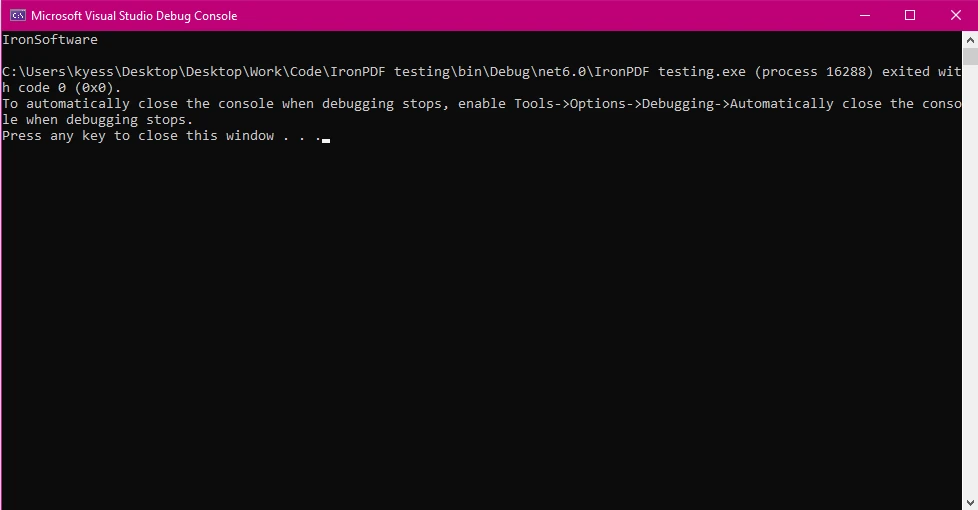
在上述範例中,我們創建了一個名為 GlobalSettings 的公共類,該類包含了全域變數 CompanyName 和 LogoPath。 接著,我們在主方法中使用 GlobalSettings.CompanyName 存取 CompanyName 變數。
要開始使用IronPDF,您首先需要安裝它。 如果已經安裝,則可以跳到下一節,否則以下步驟將介紹如何安裝IronPDF庫。
To安裝 IronPDF使用 NuGet 套件管理器主控台,開啟 Visual Studio 並導航至套件管理器主控台。 然後執行以下命令:
Install-Package IronPdfInstall-Package IronPdf'INSTANT VB TODO TASK: The following line uses invalid syntax:
'Install-Package IronPdf就這樣! IronPDF 將被添加到您的專案,您可以立即開始工作。
打開 Visual Studio,前往「工具 -> NuGet 套件管理員 -> 為方案管理 NuGet 套件」並搜尋 IronPDF。 從這裡開始,您只需選擇您的專案並點擊「安裝」,IronPDF 就會被添加到您的專案中。
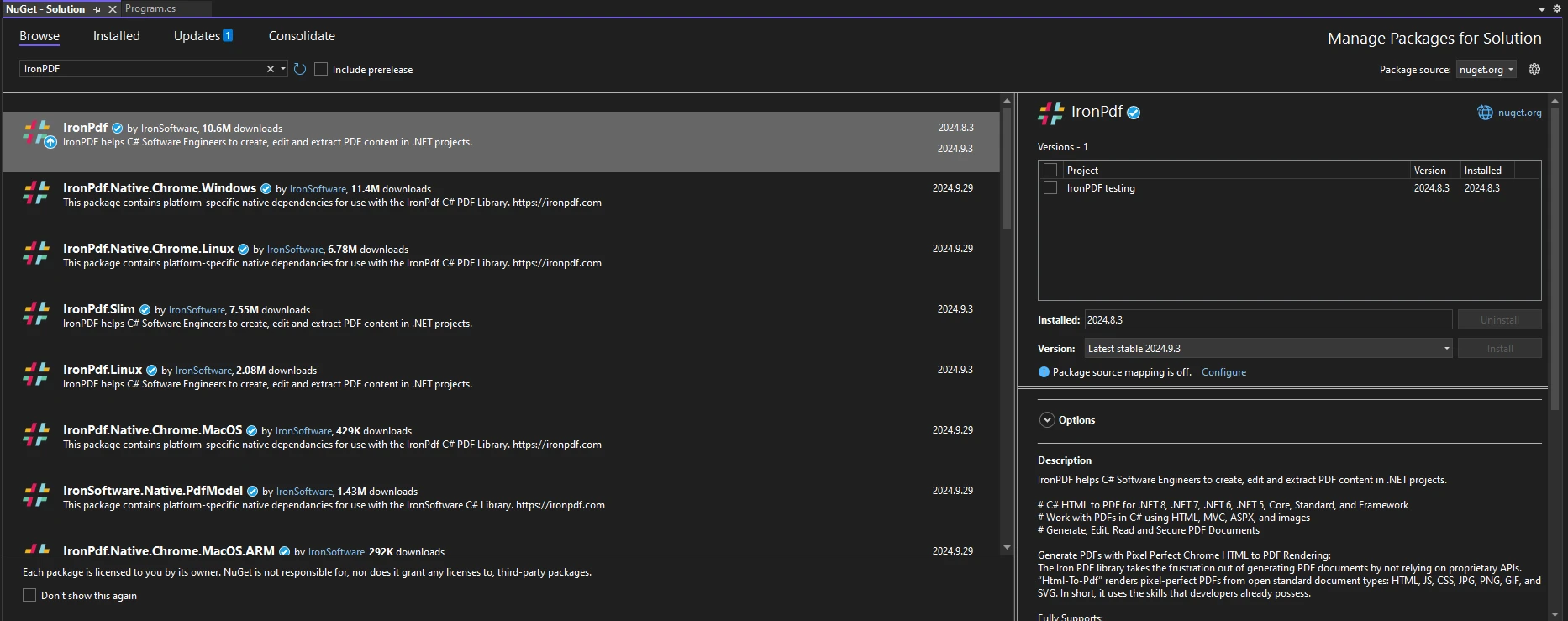
安裝 IronPDF 後,您只需在程式碼的頂部新增正確的 using 語句即可開始使用 IronPDF:
using IronPdf;using IronPdf;Imports IronPdf當您想確保多個 PDF 文件的一致性時,全域變數特別有用。 例如,如果您的 PDF 報告需要在每一頁中包含公司名稱和標誌,您可以全局儲存這些資料。
以下是一個例子,說明如何使用這些全域變數將公司名稱和標誌插入由 IronPDF 生成的每個 PDF 中:
using System;
using IronPdf;
public class GlobalSettings
{
// Static members of the global settings class
public static string CompanyName = "IronSoftware";
public static string LogoPath = "IronPdfLogo.png";
}
class Program
{
static void Main(string[] args)
{
ChromePdfRenderer renderer = new ChromePdfRenderer();
string htmlContent = $@"
<html>
<body>
<header>
<h1>{GlobalSettings.CompanyName}</h1>
<img src='{GlobalSettings.LogoPath}' />
</header>
<p>This is a dynamically generated PDF using global variables!</p>
</body>
</html>";
PdfDocument pdf = renderer.RenderHtmlAsPdf(htmlContent);
pdf.SaveAs("globalVar.pdf");
}
}using System;
using IronPdf;
public class GlobalSettings
{
// Static members of the global settings class
public static string CompanyName = "IronSoftware";
public static string LogoPath = "IronPdfLogo.png";
}
class Program
{
static void Main(string[] args)
{
ChromePdfRenderer renderer = new ChromePdfRenderer();
string htmlContent = $@"
<html>
<body>
<header>
<h1>{GlobalSettings.CompanyName}</h1>
<img src='{GlobalSettings.LogoPath}' />
</header>
<p>This is a dynamically generated PDF using global variables!</p>
</body>
</html>";
PdfDocument pdf = renderer.RenderHtmlAsPdf(htmlContent);
pdf.SaveAs("globalVar.pdf");
}
}Imports System
Imports IronPdf
Public Class GlobalSettings
' Static members of the global settings class
Public Shared CompanyName As String = "IronSoftware"
Public Shared LogoPath As String = "IronPdfLogo.png"
End Class
Friend Class Program
Shared Sub Main(ByVal args() As String)
Dim renderer As New ChromePdfRenderer()
Dim htmlContent As String = $"
<html>
<body>
<header>
<h1>{GlobalSettings.CompanyName}</h1>
<img src='{GlobalSettings.LogoPath}' />
</header>
<p>This is a dynamically generated PDF using global variables!</p>
</body>
</html>"
Dim pdf As PdfDocument = renderer.RenderHtmlAsPdf(htmlContent)
pdf.SaveAs("globalVar.pdf")
End Sub
End Class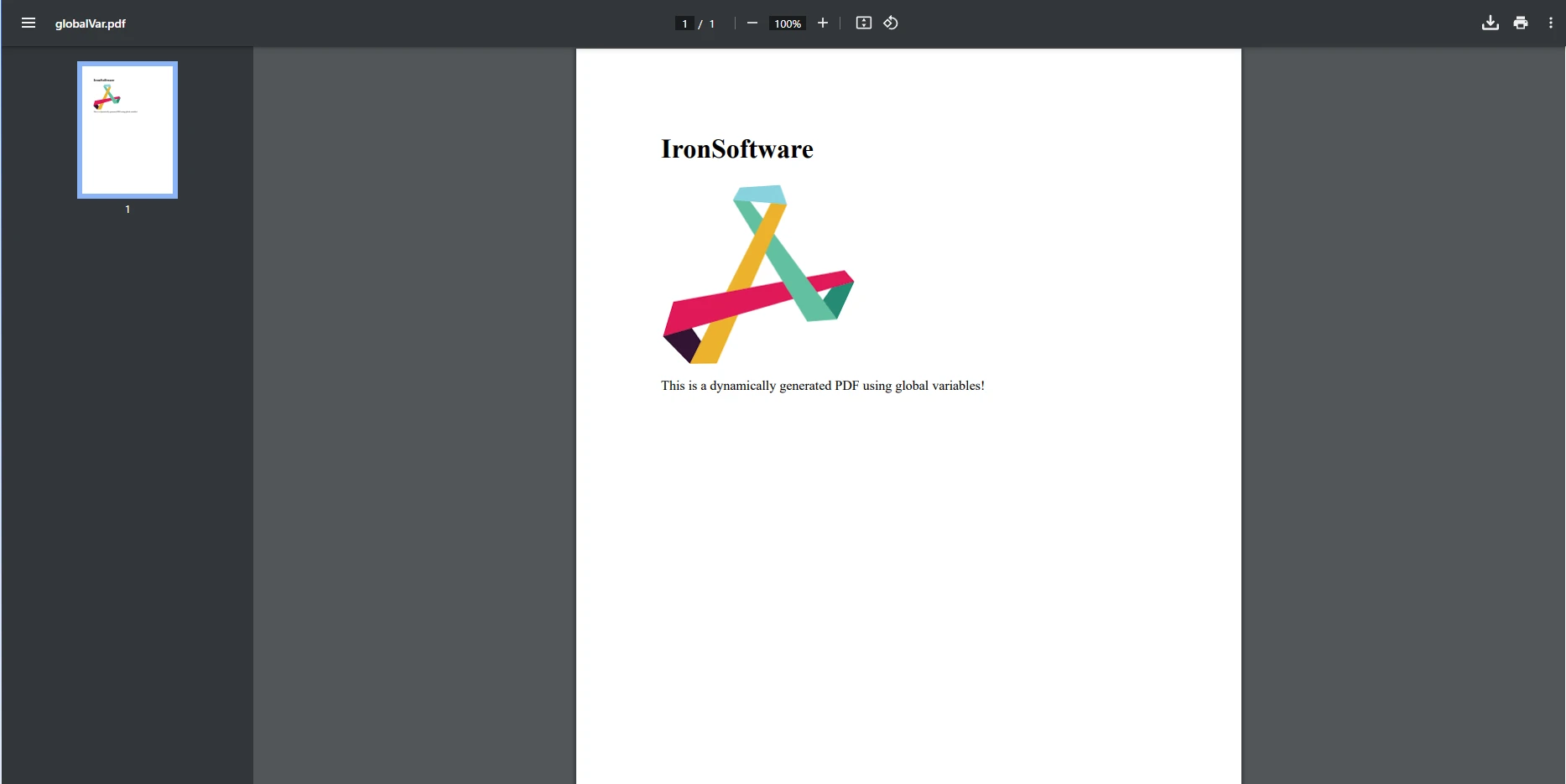
在此範例中,我們實例化ChromePdfRenderer類別來創建一個新的ChromePdfRenderer渲染器,我們將使用它來將HTML內容渲染為PDF。 HTML 內容包括我們的靜態在之前的例子中,我們創建的全域變數,CompanyName 和 LogoPath。 然後我們使用RenderHtmlAsPdf方法搭配我們的PdfDocument物件用於將 HTML 內容轉換為 PDF,最後保存生成的 PDF。
想像一下這樣的場景:您想要生成財務報告,並且需要在每份報告中包含貴公司的品牌標識。 透過使用全域變數,您可以儲存公司的名稱、標誌和其他相關資訊,並在所有生成的PDF中一致地應用。
using System;
using IronPdf;
public class GlobalSettings
{
// static variable types go here
public static string CompanyName = "IronSoftware";
public static string ReportContent { get; set; } = "This is the default report content.";
public static string FooterText = "Created using IronPDF and Global Variables";
}
public class PDFReport
{
public static void SetDynamicContent(string reportContent)
{
GlobalSettings.ReportContent = reportContent;
}
public static void GenerateReport()
{
ChromePdfRenderer renderer = new ChromePdfRenderer();
// Using global variables in HTML content
string htmlTemplate = $@"
<html>
<body>
<header style='text-align:center;'>
<h1>{GlobalSettings.CompanyName}</h1>
</header>
<section>
<p>{GlobalSettings.ReportContent}</p>
</section>
<footer style='text-align:center;'>
<p>{GlobalSettings.FooterText}</p>
</footer>
</body>
</html>";
PdfDocument pdf = renderer.RenderHtmlAsPdf(htmlTemplate);
pdf.SaveAs("dynamic_report.pdf");
}
}
class Program
{
static void Main(string[] args)
{
// Set global variables dynamically at runtime
PDFReport.SetDynamicContent("This report highlights the latest innovations in technology.");
PDFReport.GenerateReport();
}
}using System;
using IronPdf;
public class GlobalSettings
{
// static variable types go here
public static string CompanyName = "IronSoftware";
public static string ReportContent { get; set; } = "This is the default report content.";
public static string FooterText = "Created using IronPDF and Global Variables";
}
public class PDFReport
{
public static void SetDynamicContent(string reportContent)
{
GlobalSettings.ReportContent = reportContent;
}
public static void GenerateReport()
{
ChromePdfRenderer renderer = new ChromePdfRenderer();
// Using global variables in HTML content
string htmlTemplate = $@"
<html>
<body>
<header style='text-align:center;'>
<h1>{GlobalSettings.CompanyName}</h1>
</header>
<section>
<p>{GlobalSettings.ReportContent}</p>
</section>
<footer style='text-align:center;'>
<p>{GlobalSettings.FooterText}</p>
</footer>
</body>
</html>";
PdfDocument pdf = renderer.RenderHtmlAsPdf(htmlTemplate);
pdf.SaveAs("dynamic_report.pdf");
}
}
class Program
{
static void Main(string[] args)
{
// Set global variables dynamically at runtime
PDFReport.SetDynamicContent("This report highlights the latest innovations in technology.");
PDFReport.GenerateReport();
}
}Imports System
Imports IronPdf
Public Class GlobalSettings
' static variable types go here
Public Shared CompanyName As String = "IronSoftware"
Public Shared Property ReportContent() As String = "This is the default report content."
Public Shared FooterText As String = "Created using IronPDF and Global Variables"
End Class
Public Class PDFReport
Public Shared Sub SetDynamicContent(ByVal reportContent As String)
GlobalSettings.ReportContent = reportContent
End Sub
Public Shared Sub GenerateReport()
Dim renderer As New ChromePdfRenderer()
' Using global variables in HTML content
Dim htmlTemplate As String = $"
<html>
<body>
<header style='text-align:center;'>
<h1>{GlobalSettings.CompanyName}</h1>
</header>
<section>
<p>{GlobalSettings.ReportContent}</p>
</section>
<footer style='text-align:center;'>
<p>{GlobalSettings.FooterText}</p>
</footer>
</body>
</html>"
Dim pdf As PdfDocument = renderer.RenderHtmlAsPdf(htmlTemplate)
pdf.SaveAs("dynamic_report.pdf")
End Sub
End Class
Friend Class Program
Shared Sub Main(ByVal args() As String)
' Set global variables dynamically at runtime
PDFReport.SetDynamicContent("This report highlights the latest innovations in technology.")
PDFReport.GenerateReport()
End Sub
End Class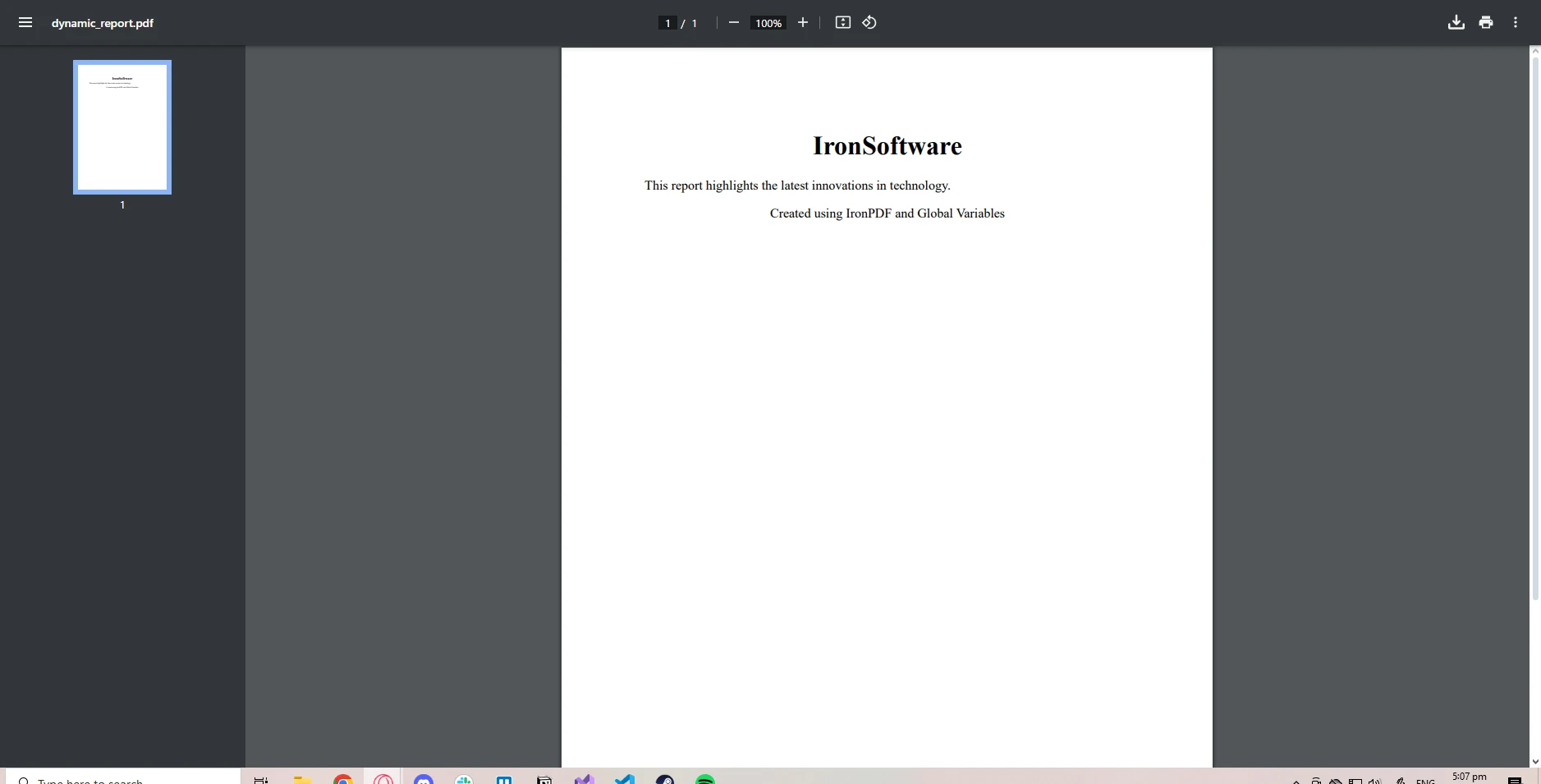
在此範例中,我們在 GlobalSettings 類別中建立了一個名為 ReportContent 的全域變數。這個變數有 `get` 和 `set` 方法,可在執行時更新其值。SetGlobalVariables 方法允許在建立 PDF 之前動態設置全域變數。 此方法可以擴展為從配置文件、資料庫或用戶輸入中獲取數據。 這HTML 內容用於創建 PDF 的內容是根據全域變數的值動態生成的。
全域變數很方便,但應該僅在它們能使程式碼簡化並減少冗餘時才使用。 例如,將全域變數用於應用程式設定、常用資源或 PDF 生成中的常數,可以節省時間並防止錯誤。
然而,如果您的全域資料容易變動或僅在特定情境下相關,最好透過方法參數傳遞資料或使用相依性注入,以確保更好的程式碼結構和可維護性。
全域變數的一些常見問題包括緊密耦合,使元件相互依賴,從而使測試或修改代碼變得更加困難。 以下是避免這些陷阱的一些提示:
全域變數也可以儲存像檔案路徑、資料結構、模板或圖像資源等常用資源。 通過這樣做,您優化了PDF生成,因為這些資源在不同的PDF報告中被緩存和重用。
using System;
using IronPdf;
public class GlobalSettings
{
public static readonly string TemplatePath = "report.html";
public static readonly string ImageDirectory = "IronPdfLogo.png";
}
public class PDFReport
{
public static void GenerateReport()
{
ChromePdfRenderer renderer = new ChromePdfRenderer();
// local variable for the file content
string templateContent = File.ReadAllText(GlobalSettings.TemplatePath);
PdfDocument pdf = renderer.RenderHtmlAsPdf(templateContent);
pdf.SaveAs("templateReport.pdf");
}
}
class Program
{
static void Main(string[] args)
{
// Set global variables dynamically at runtime
PDFReport.GenerateReport();
}
}using System;
using IronPdf;
public class GlobalSettings
{
public static readonly string TemplatePath = "report.html";
public static readonly string ImageDirectory = "IronPdfLogo.png";
}
public class PDFReport
{
public static void GenerateReport()
{
ChromePdfRenderer renderer = new ChromePdfRenderer();
// local variable for the file content
string templateContent = File.ReadAllText(GlobalSettings.TemplatePath);
PdfDocument pdf = renderer.RenderHtmlAsPdf(templateContent);
pdf.SaveAs("templateReport.pdf");
}
}
class Program
{
static void Main(string[] args)
{
// Set global variables dynamically at runtime
PDFReport.GenerateReport();
}
}Imports System
Imports IronPdf
Public Class GlobalSettings
Public Shared ReadOnly TemplatePath As String = "report.html"
Public Shared ReadOnly ImageDirectory As String = "IronPdfLogo.png"
End Class
Public Class PDFReport
Public Shared Sub GenerateReport()
Dim renderer As New ChromePdfRenderer()
' local variable for the file content
Dim templateContent As String = File.ReadAllText(GlobalSettings.TemplatePath)
Dim pdf As PdfDocument = renderer.RenderHtmlAsPdf(templateContent)
pdf.SaveAs("templateReport.pdf")
End Sub
End Class
Friend Class Program
Shared Sub Main(ByVal args() As String)
' Set global variables dynamically at runtime
PDFReport.GenerateReport()
End Sub
End Class輸入模板
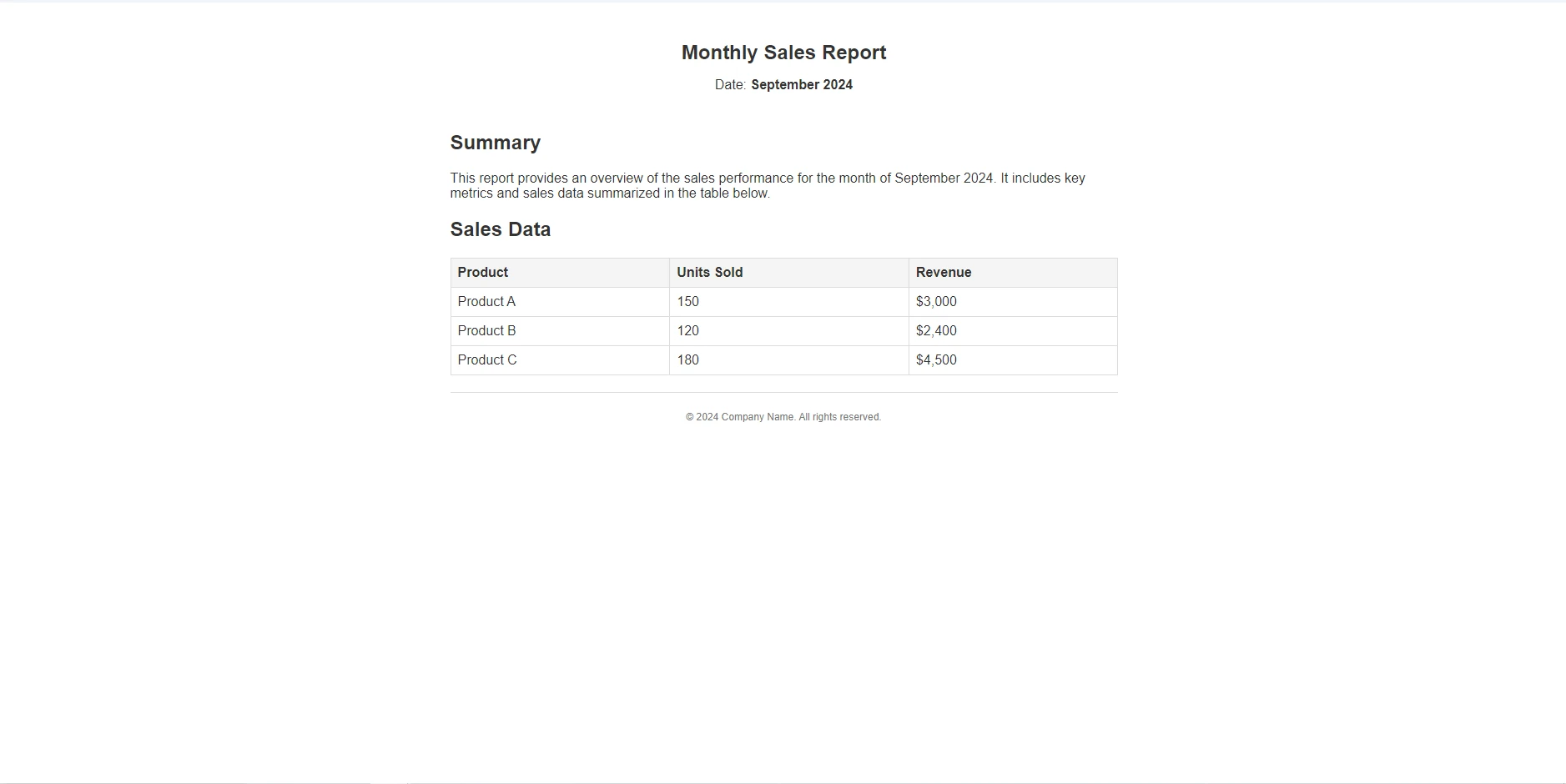
輸出
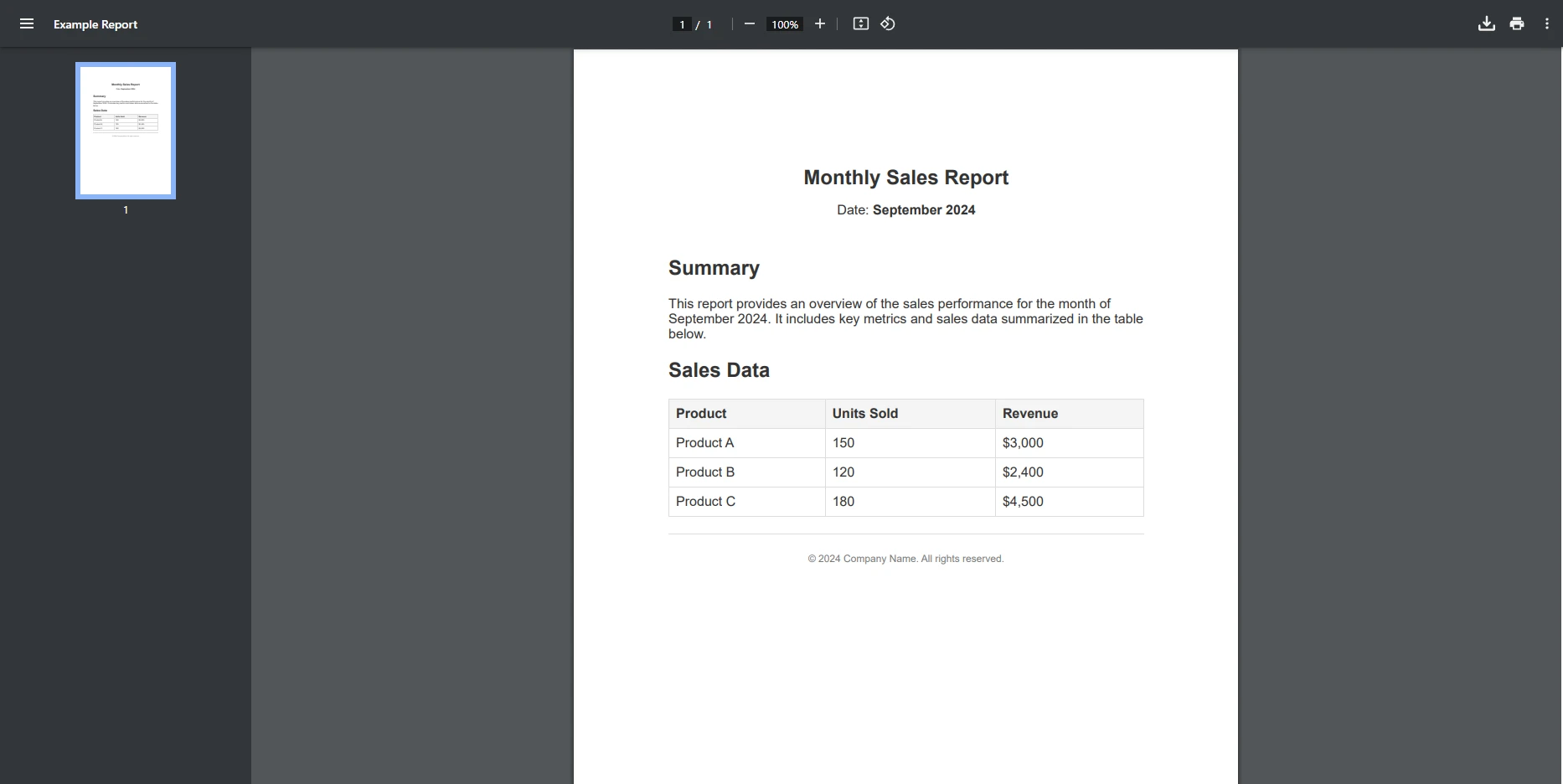
IronPDF擁有豐富的功能集,這些功能使處理PDF文檔變得輕而易舉,且可處理從簡單的HTML到PDF的轉換,再到PDF加密和解密的所有內容。
在處理數據驅動的 PDF 生成時,IronPDF 提供了多項功能,簡化了從全球數據生成這些 PDF 的過程:
IronPDF與 .NET 應用程式順利整合,並支援使用靜態數據或配置設定以保持一致的 PDF 生成。 這是一個通用的庫,非常適用於需要共享數據以生成專業 PDF 文件的應用程式。 結合全域變數的強大功能,您將能夠使用IronPDF有效簡化所有PDF生成任務。
全域變數是一種出色的方式來管理應用程式中共享的數據,它們可以無縫地與IronPDF看看IronPDF如何簡化您今天的PDF生成過程。